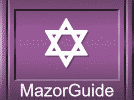|
• The Ring
• Why a Ring
• Significance of the
Ring's Shape
• Plain Wedding Bands
• Wedding Ring Metals
• Borrowed and Heirloom Rings
• The Ring Ceremony
The Ring
Erusin ends with the groom giving a ring to his bride.
Formal wedding ceremonies are an extra measure in the eyes of halacha. Traditionally, when a woman accepted a wedding ring, she was signaling her change of personal status and her agreement to the provisions in the ketubah.
Coins, property deeds, or even fruit qualified to establish a marriage, but rings became customary. Some Syrian-Jewish grooms present special marriage coins to their brides. A deed, fruit, prayer book, or anything with real monetary value is valid.
Why a Ring?
When Pharoah designated Joseph as his minister of finance, he handed him the royal ring. (Genesis 41:42) Later on, in the Purim saga, Achasheverosh first gave
Haman the power to destroy the Jewish people and then gave Esther the power to issue edicts by handing over his royal signet ring (Book of Esther 3:10, 8:2). A wife is given the power to manage and share stewardship over her husband’s household. This, too, is signified by the presentation of the ring.
Significance of the Ring’s Shape
Where does a circle end? A ring has no perceivable ending point. Neither should love between husband and wife.
Basic to the Jewish understanding of gender is the idea that men and women have very different spiritual strengths. In marriage these forces are shared. A bride circles her groom, symbolizing the spiritual characteristics she contributes to her husband. Men wear a tallit after they marry (according to some customs) as physical evidence of the spiritual aura gained in marriage. Women wear wedding rings, which encircle the finger, as a tangible reminder of the new holiness that envelopes them thanks to their husbands.
Plain Wedding Bands
One reason Jewish tradition favors smooth bands, without engraving, frills, or stones is because they have readily ascertainable value. halacha
gets technical here, but part of the nuptial formula translates as “Behold you
become holy unto me with this ring.” If “this ring” was not what it appeared to
be, then a marriage’s status as a legal entity would be called into question.
When plain wedding rings are used by all, poor brides are not embarrassed by their unadorned wedding rings. Kabbalistic sources suggest smooth rings would portend an untroubled life. Yet in 17th and 18th century Eastern Europe, some Jewish communities used rings fashioned to look like miniature houses to symbolize the home a couple would build together.
Georgian Jews adapted a local custom and placed the ring into the Kiddush
cup used at the ceremony.
Wedding Ring Metals
Gold is a traditional choice, because it was long thought of as the most valuable metal. Just as many facets of the wedding ceremony parallel the Genesis account of the world’s birth to signify the couple’s role as creators, gold is found in the Garden of Eden. One of the four rivers of Eden was said to have gold deep within it (Genesis 2:11-12).
Silver was a choice ring material as well. In Hebrew, the word for silver is “kesef”, and the word for desire is “kesufin.”
Whatever the ring is made out of, its value should be easily identifiable. Brass that can be mistaken for gold isn’t a good choice. Emphasis is placed on rings of unmistakable worth because marriages are established by the acceptance of an item of value, known value, not on the ring itself.
Ever bite into a custard doughnut only to discover it was unfilled? That’s the sort of rude surprise halachic authorities were looking to avoid when they cautioned grooms against handing an engraved wedding ring to a bride.
Borrowed and Heirloom Rings
Marriage is a contract of love and responsibility between exactly two people. Consequently, the ring should be the groom’s own, not borrowed. To use an heirloom ring, it should first be given as a gift to the groom. That way it will be his to give to the bride.
Ring Ceremony
Here is the heart of the ceremony. Before the ring is presented some technicalities need to be cleared up. With the ring in hand, the rabbi asks if the ring belongs to the groom. (The correct answer is “yes,” and it should be true, too.) Then the rabbi will ask if the ring is worth more than a
p’rutah, and, from the bride’s point of view, it ought to be. In today’s measurement a p’rutah, which an ancient coin, is valued at 25 mg of silver or 4/5th of a penny.
After answering this question with a “yes,” the groom steadies his trembling hands enough to slide the ring on his bride’s finger. Like the Torah that was figuratively given “from His right hand” (Deuteronomy 33:2), the groom presents the ring with his right hand.
A thoughtful bride will extend her right index finger to guide the overwhelmed groom. One reason a ring is placed here is because it is easier for the witnesses to see the ring when it is placed on the index finger.
Counting from the pinky on the left hand, the right index finger is the seventh, like the seventh day of creation. Rabbeinu Bachya adds each finger is linked to one of the five senses: pinky for hearing, ring finger for sight, middle finger for touch, index finger for smell, thumb for taste. The sense of smell is associated with sexuality, which finds its holiest expression in marriage.
Wives used to keep their wedding bands on their index fingers or middle fingers. Now the ring generally resides on the ring finger, the fourth from the thumb. Once the ceremony ends, the general tradition is to move the ring to the fourth finger.


|







